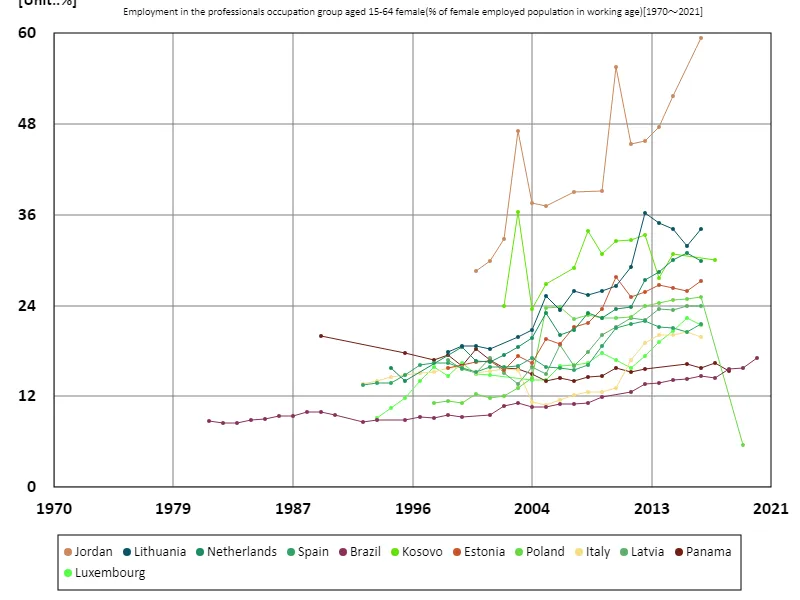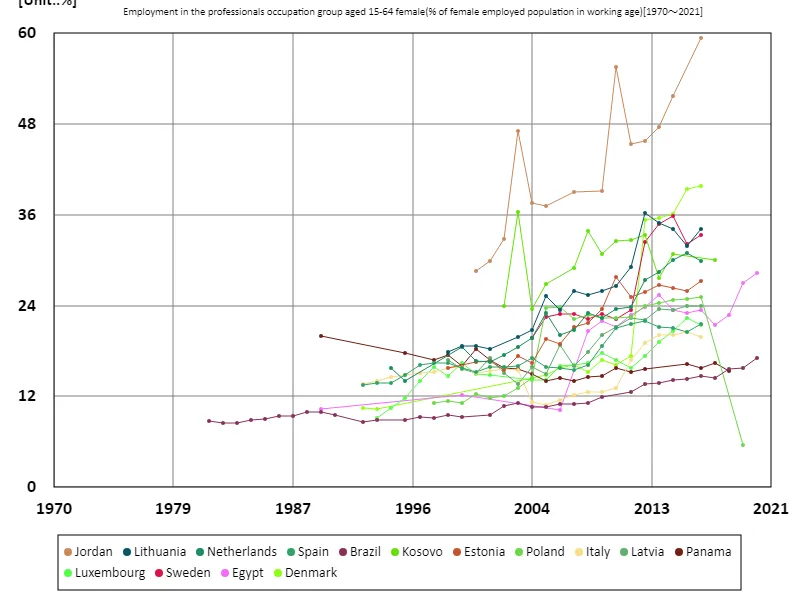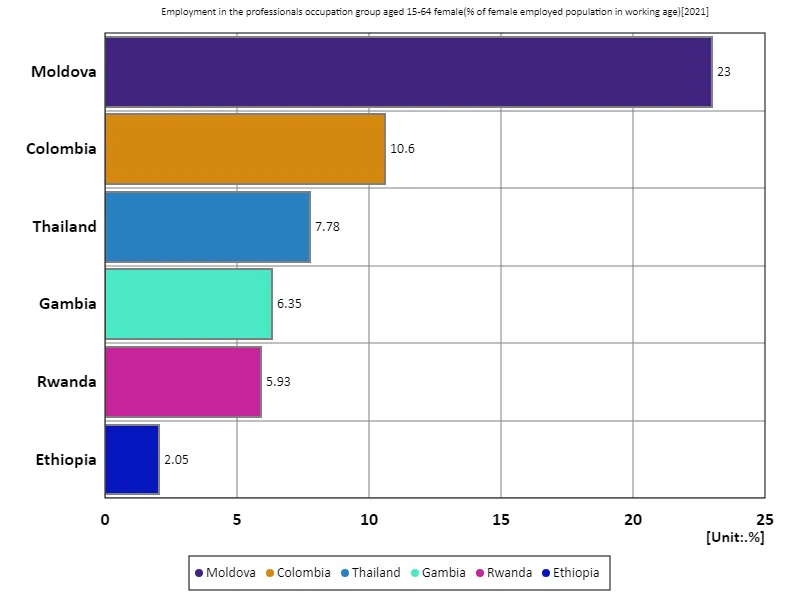- Abstract
- Employment rate for women aged 15-64 in the professional sector (percentage of working-age female employment population)
- Employment rate of women aged 15-64 in the professional sector (percentage of working-age female employment population) (Worldwide)
- Employment rate of women aged 15-64 in the professional sector (percentage of working-age female employment population) (Worldwide, latest year)
- Reference
Abstract
Employment rates for women aged 15-64 in the professional sector vary widely depending on the country’s stage of economic development and social structure. According to 2020 data, Brazil has the highest female employment rate in the professional sector at 17.1%. This reflects the improvement in the educational attainment of women in Brazil and their advancement in the labor market. Meanwhile, compared to developed countries, Brazil’s high female employment rate in the professional sector can be attributed to its fast-growing economy and diverse industries. In contrast, in many other countries, women are often relatively underrepresented in the professional sector. This is due to unequal educational opportunities and gender-based barriers in the workplace. Additionally, while there has been a trend toward more women entering professional roles alongside economic development, gender discrimination in the workplace and disparities in job titles remain issues. Future policies will need to address gender equality and support greater advancement of women in professional fields.
Employment rate for women aged 15-64 in the professional sector (percentage of working-age female employment population)
Across data from 1981 to 2020, there are notable changes and regional differences in employment rates in the professional sector for women aged 15-64. Particularly noteworthy is the high employment rate of 59.3% recorded in Jordan in 2016. This figure reflects the progress of women in professional fields in Jordan, likely due to economic and educational improvements at the time. However, in Jordan, employment rates have since fallen by 100% since their peak. This may be due to economic conditions, social changes, policy shifts, etc. While there is an overall trend towards more women entering the professional sector in many countries, there are significant regional differences. In developing countries, as educational opportunities expand, there is a trend for entry into the professional professions to increase, but at the same time, changes in the labour market and economic instability can have an impact. In contrast, developed countries have seen relatively stable employment rates but slower progress on gender equality in some cases. The data shows that female employment rates in the professional sector are highly dependent on many factors, including economic growth, education systems and policy changes. Appropriate policies and support tailored to each country’s circumstances will contribute to improving employment rates in the future.


The maximum is the latest one, 59.3% of Jordan
Employment rate of women aged 15-64 in the professional sector (percentage of working-age female employment population) (Worldwide)
Across the data from 1981 to 2020, there are notable regional differences and variations in the share of women aged 15-64 in the professional sector. Particularly noteworthy is the high employment rate of 59.3% recorded in Jordan in 2016. This figure marks the peak of women’s advancement into professional jobs in Jordan, and is thought to have been largely influenced by the economic growth and educational reforms of the time. However, in Jordan, this employment rate is now down 100% from its peak, suggesting a major shift in the employment landscape for women in the professional sector. This could be due to a variety of factors, including economic instability, social change and policy shifts. The example of Jordan shows that the employment rate of women in professional fields is greatly influenced not only by developments in education and policy, but also by changes in the economic and social environment. Overall, female employment rates in the professional sector vary across countries at different stages of economic development, social structures and educational attainment. While more women are entering professional careers as their education improves, particularly in developing countries, progress in gender equality remains a challenge even in developed countries. Policies and social support tailored to each country’s circumstances will have a major impact on future employment rates.


The maximum is the latest one, 59.3% of Jordan
Employment rate of women aged 15-64 in the professional sector (percentage of working-age female employment population) (Worldwide, latest year)
According to 2021 data, Moldova has the highest employment rate in the professional sector for women aged 15-64 at 23%, while the average is 9.29% and the total is 55.7%. Moldova’s high employment rate is likely due to the country’s economic growth and improving educational standards. Moldova is one of the countries where women are making great strides, especially in education and the professional professions. However, the average figure of 9.29% indicates that in many countries, women’s advancement in professional careers is still limited. This is due to a lack of educational opportunities, gender-based barriers and insufficient improvements in the workplace. The combined figure of 55.7% suggests that while the overall trend is one in which many countries are gradually moving towards more women entering professional fields, there are still significant regional and economic disparities. These data make it clear that improving women’s employment rates in the professional sector requires better education, equal opportunities in the workplace, and social support. In particular, given the low average value, further policy strengthening and implementation is required.


The maximum is 23% of Moldova, the average is 9.29%, and the total is 55.7%



Comments